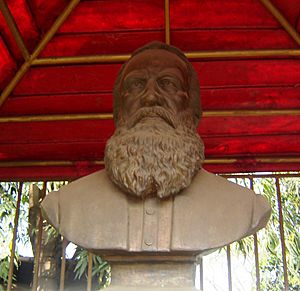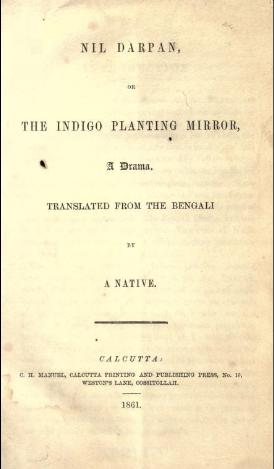James Long (priest) facts for kids
James Long (1814–1887) was an Anglo-Irish priest from the Anglican Church. He was a kind person who loved helping others, an educator, and a missionary in India. He lived in Calcutta, India, from 1840 to 1872. He worked with the Church Missionary Society and led their mission in Thakurpukur.
Long was involved with many important groups in Calcutta, like the Calcutta School-Book Society. He also published an English translation of the play Nil Darpan. This act led to him being fined and briefly put in jail.
Contents
Early Life and Education
James Long was born in Bandon, County Cork, Ireland, in 1814. At age twelve, he joined the Bandon Endowed School. There, he learned many languages, math, and history. He was a very good student, especially in religious studies and classic subjects.
In 1838, Long was accepted into the Church Missionary Society. He trained for two years at their college in Islington. Reverend Long then traveled to Calcutta to join the CMS mission. He arrived in Calcutta in 1840. In 1848, he briefly went back to England to marry Emily Orme.
Working in Calcutta and Thakurpukur
From 1840 to 1848, James Long taught at a school for non-Christian students. This school was run by the CMS on Amherst Street in Calcutta. After returning to India with his wife in 1848, he took charge of the CMS mission in Thakurpukur. At that time, Thakurpukur was a small village outside Calcutta.
By 1851, Long had started a local language school for boys in Thakurpukur. His wife, Emily, ran a similar school for girls. In 1854, he proudly wrote that his school had "about 100 boys," including Hindu, Muslim, and Christian students. His book Bengali Proverbs (1851) was an important addition to Bengali literature. He continued to study Bengali proverbs and folk stories for many years. He also published lists of Bengali newspapers and books.
The Nil Darpan Play Controversy
In 1861, there was a big protest by farmers in Bengal called the Indigo revolt. These farmers, known as ryots, worked on indigo plantations. James Long received a copy of the Bengali play Nil Darpan from its author, Dinabandhu Mitra. Mitra had been one of Long's students. The play, published a year earlier, showed the difficult lives of the indigo farmers. It also criticized European plantation owners for how they treated the workers.
Long thought the play was very important. He showed it to Walter Scott Seton-Karr, a government official. Seton-Karr then told the Lieutenant Governor, John Peter Grant, about it. Grant wanted an English translation of the play. He planned to print a few copies to share privately with friends. Long had the play translated anonymously "By A Native." He then had 500 copies printed in April or May 1861. In his introduction, Long wrote that he hoped for peace between the planters and the farmers.
Long sent copies of the translated play in official government envelopes. These envelopes were marked "on her Majesty’s Service." This meant they looked like official government documents.
The play made the indigo planters very angry. They felt the play insulted them and their newspapers. They believed the play made them look bad. W. F. Fergusson, from the Landholders' and Commercial Association, wrote to the Governor of Bengal. He asked who had allowed the play to be published. He also threatened to take legal action against those who spread what he called "malicious libel." The Lieutenant Governor replied that some officials had caused the problem. The planters were not happy with this answer. They decided to go to court to find out who wrote and published Nil Darpan.
Long's introduction to the play said that what was shown in it was "plain but true." The planters used these words against him in court. C. H. Manuel, the printer, was charged in the Calcutta Supreme Court on June 11, 1861. He admitted guilt and, following Long's advice, named Long as the person who hired him to print the play.
Long's trial took place from July 19 to 24, 1861. The judge found Long guilty. He was fined one thousand rupees and sentenced to one month in prison. He served his time in July and August 1861. A kind person named Kaliprasanna Singha paid Long's fine for him.
Later Life and Lasting Impact
After three years of leave, Reverend and Mrs. Long returned to Calcutta. Sadly, Mrs. Long died in February 1867 while traveling back to England. After her death, Long shared a house in Calcutta with his friend, Reverend Krishna Mohan Banerjee. They both had lost their wives that same year.
Together, Long and Banerjee hosted social gatherings that brought together British and Indian people. This was rare during the colonial era. They wanted to help British and Indian communities become friends. Important guests like Bishop George Cotton and Keshub Chunder Sen attended these events.
Long continued his work in education. He also became very interested in Russia. He visited Russia for the first time in 1863 and twice more after he retired in 1872. In a paper he wrote in 1865, Long shared his hopeful thoughts about the end of serfdom in Russia. He also believed Russia could help spread Christianity in Central Asia.
In 1872, Reverend James Long retired from the Church Missionary Society and left India for good. He lived the rest of his life in London. He continued to write and publish until he passed away on March 23, 1887. In 1885, Long created a special fund called the Long Lectureship in Oriental Religions. This fund helps pay for lecturers to give talks about Eastern religions in Britain.
Today, a major road in Thakurpukur is named James Long Sarani, in his honor.



